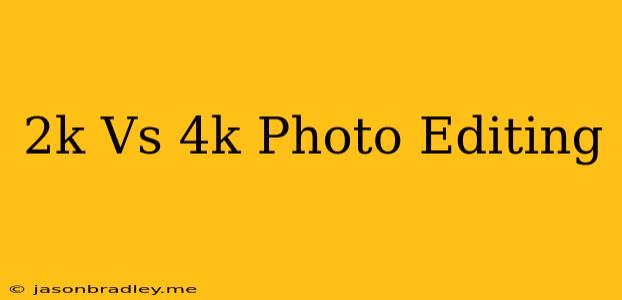2K vs. 4K: The Ultimate Guide for Photo Editing
When it comes to photo editing, the resolution of your images can significantly impact your workflow and final output. While 2K (1920 x 1080 pixels) has long been the standard, 4K (3840 x 2160 pixels) is quickly becoming the go-to choice for photographers and editors alike. But which resolution is right for you?
Let's delve into the key differences between 2K and 4K photo editing, exploring the pros and cons of each to help you make an informed decision.
2K: The Tried and True
Pros:
- Smaller File Size: 2K images are significantly smaller than 4K images, making them easier to store, share, and upload online.
- Faster Processing: Due to their smaller size, 2K images can be processed much quicker, leading to faster editing times and less strain on your computer.
- Wide Compatibility: 2K is widely supported by almost every device and software, ensuring compatibility with existing tools and workflows.
Cons:
- Limited Detail: 2K images lack the detail and clarity of 4K, potentially limiting your ability to crop, resize, or edit with precision.
- Less Versatility: 2K might not be ideal for large prints or high-resolution displays, as the image may appear pixelated or blurry.
4K: The High-Resolution Powerhouse
Pros:
- Exceptional Detail and Clarity: 4K images offer incredible detail and clarity, allowing for meticulous editing and stunning prints.
- Greater Versatility: 4K provides ample room for cropping, resizing, and even creating large-scale prints without sacrificing quality.
- Future-Proofing: 4K is becoming the new standard, ensuring compatibility with future devices and software.
Cons:
- Larger File Size: 4K images require significantly more storage space and can be slow to upload or transfer.
- Resource-Intensive: Editing 4K images can be demanding on your computer, requiring powerful hardware to avoid lag or crashes.
- Potential for Overkill: For some purposes, 2K might offer more than enough resolution, making 4K unnecessary and potentially cumbersome.
Choosing the Right Resolution
Ultimately, the best resolution for your photo editing needs depends on your specific goals and workflow.
Consider choosing 2K if:
- You prioritize file size and processing speed.
- You primarily edit photos for online use or social media.
- You are working with limited storage space or a less powerful computer.
Consider choosing 4K if:
- You want the highest possible detail and clarity for printing or large-scale displays.
- You intend to crop or resize images extensively.
- You have the storage space and processing power to handle large file sizes.
Remember: The best approach might involve a combination of both resolutions, using 4K for projects requiring maximum detail and 2K for everyday use or online sharing.
No matter your choice, understanding the differences between 2K and 4K can help you make informed decisions that optimize your photo editing experience.
